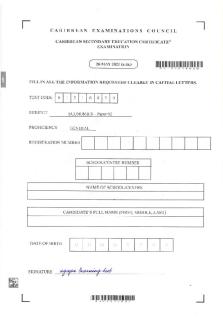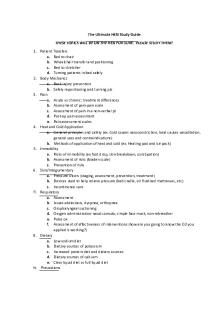HESI Study Guide-Ultimate july 2021 PDF

| Title | HESI Study Guide-Ultimate july 2021 |
|---|---|
| Author | Amber C |
| Course | Fundamentals of Nursing |
| Institution | Fortis College |
| Pages | 4 |
| File Size | 89.9 KB |
| File Type | |
| Total Downloads | 226 |
| Total Views | 948 |
Summary
The Ultimate HESI Study Guide THESE TOPICS WILL BE ON THE HESI FOR SURE. PLEASE STUDY THEM! Patient Transfers a. Bed to chair b. Wheelchair transfer and positioning c. Bed to stretcher d. Turning patients in bed safely Body Mechanics a. Back injury prevention b. Safely repositioning and turning pts ...
Description
The Ultimate HESI Study Guide THESE TOPICS WILL BE ON THE HESI FOR SURE. PLEASE STUDY THEM! 1. Patient Transfers a. Bed to chair b. Wheelchair transfer and positioning c. Bed to stretcher d. Turning patients in bed safely 2. Body Mechanics a. Back injury prevention b. Safely repositioning and turning pts 3. Pain a. Acute vs chronic: treatment differences b. Assessment of pain-pain scale c. Assessment of pain in a non-verbal pt d. Post-op pain assessment e. Pain assessment scales 4. Heat and Cold Application a. General principles and safety (ex. Cold causes vasoconstriction, heat causes vasodilation, general uses and contraindications) b. Methods of application of heat and cold (ex. Heating pad and ice pack) 5. Immobility a. Risks of immobility (ex foot drop, skin breakdown, constipation) b. Assessment of risks (braden scale) c. Prevention of risks 6. Skin/Integumentary a. Pressure Ulcers (staging, assessment, prevention, treatment) b. Devices used to help relieve pressure (bed cradle, air fluidized mattresses, etc) c. Incontinence care 7. Respiratory a. Assessment b. Issues-atelectasis, dyspnea, orthopnea c. Oropharyngeal suctioning d. Oxygen administration-nasal cannula, simple face mask, non-rebreather e. Pulse ox f. Assessment of effectiveness of interventions (how are you going to know the O2 you applied is working?) 8. Dietary a. Low sodium diet b. Dietary sources of potassium c. Increased protein diet and dietary sources d. Dietary sources of calcium e. Clear liquid diet vs full liquid diet 9. Precautions
10.
11.
12.
13.
14.
15.
16.
17.
a. Standard/Universal precautions b. Contact Isolation-reasons for, what PPE is required c. Airborne Isolation d. Droplet Isolation e. Pt education on maintaining isolation principles at home Sleep a. Assessment b. Promotion c. Vital sign changes during sleep d. Sleep apnea Lab tests/Specimens a. Specimen transport b. 24 hour urine c. Fecal occult blood test d. Ova and parasites e. INR vs. PTT Electrolytes/vitamins a. Hyper/hypokalemia-causes, s/sx, treatment b. Hypo/hypernatremia c. Hypo/hypercalcemia d. Vitamin K Legal/Professional Issues a. Advanced directives b. Scope of practice c. False imprisonment d. HIPPA Communication a. Communication w/ a depressed pt b. Open ended questions c. SBAR d. Reporting serious issues w/ other nurses (ex. Theft, missing narcotic meds, etc) Vital Signs a. Normal range and terminology b. Procedure of obtaining (what if you couldn’t hear your BP?) c. Pulses (radial and apical) d. Vital sign changes during sleep (normal vs. abnormal) Nursing Process a. Evaluation of care b. Deferring assessment c. Focused assessment Client care/Interventions a. Eye and oral care for unconscious pts b. Bed baths c. Fecal impaction removal
d. Wound care (also pt teaching for wound care at home) e. Shaving a patient f. Heimlich maneuver g. Making an occupied bed h. Sterile gloving i. Ostomy care 18. Mobility a. Ambulation (safety, goals) b. Crutch/cane/walker walking c. Fall prevention 19. Restraints a. Need to know rules/regulations b. Specific types of restraints (wrist, belt) c. Bed alarms 20. Medication Administration a. Six rights b. Pt education (remember this a legal obligation) c. What do you do if you have a medication error? How should you document it? d. What if your pt refuses the med? e. Methods of administration i. Injections: 1. ID: always think TB test 2. Subcutaneous: definitely review heparin and insulin administration 3. IM: sites and z-track method ii. PO 1. liquid med preparation and measuring 2. Enteric coated medications 3. Sublingual med administration iii. Otic iv. Optic v. Via tube (NG, G tube, J tube): 1. be familiar w/ the process of administration 2. know meds that should and should not be given via tube vi. Transdermal Patches 21. Fluid Balance a. Hypovolemia: causes, s/sx (consider main labs affected), treatment b. Hypervolemia: causes, s/sx (consider main labs affected), treatment c. I&Os (be able to calculate, usually need to covert oz to mL) d. Daily weights: when do we get worried? Why do we do these? 22. Urinary Catheter a. Infection prevention b. Procedure of insertion c. Procedure of removal d. What to document after insertion
23. Death/Dying/Spirituality a. Hospice b. Grief (stages of) c. Family care d. Spirituality e. Assessment of patient preferences 24. Cultural Care a. Be familiar w/ main cultural groups and medical preferences/issues associated 25. Documentation a. Objective vs. Subjective information b. How to chart OBJECTIVELY c. Goal statements d. EMR e. Treatment refusal...
Similar Free PDFs

Pharm HESI 2021 - study
- 9 Pages

Pharm HESI Study Guide
- 3 Pages

HESI case study RSV
- 9 Pages

HESI Case Study Notes
- 20 Pages

Fundamentals HESI Study Guide
- 31 Pages

Hesi Case Study Mobility
- 4 Pages

Hesi Case Study Depression
- 1 Pages

OB HESI Study Guide
- 14 Pages

HESI Case Study Pain
- 5 Pages

ENG335 ECA July 2021 - ECA
- 4 Pages

Hesi Case Study Constipation
- 4 Pages

Psych HESI Study Guide
- 9 Pages

15. MAF151 JULY 2021-1
- 9 Pages

CSEC Economics July 2021 P2
- 20 Pages

Property Law Handbook July 2021
- 249 Pages
Popular Institutions
- Tinajero National High School - Annex
- Politeknik Caltex Riau
- Yokohama City University
- SGT University
- University of Al-Qadisiyah
- Divine Word College of Vigan
- Techniek College Rotterdam
- Universidade de Santiago
- Universiti Teknologi MARA Cawangan Johor Kampus Pasir Gudang
- Poltekkes Kemenkes Yogyakarta
- Baguio City National High School
- Colegio san marcos
- preparatoria uno
- Centro de Bachillerato Tecnológico Industrial y de Servicios No. 107
- Dalian Maritime University
- Quang Trung Secondary School
- Colegio Tecnológico en Informática
- Corporación Regional de Educación Superior
- Grupo CEDVA
- Dar Al Uloom University
- Centro de Estudios Preuniversitarios de la Universidad Nacional de Ingeniería
- 上智大学
- Aakash International School, Nuna Majara
- San Felipe Neri Catholic School
- Kang Chiao International School - New Taipei City
- Misamis Occidental National High School
- Institución Educativa Escuela Normal Juan Ladrilleros
- Kolehiyo ng Pantukan
- Batanes State College
- Instituto Continental
- Sekolah Menengah Kejuruan Kesehatan Kaltara (Tarakan)
- Colegio de La Inmaculada Concepcion - Cebu
